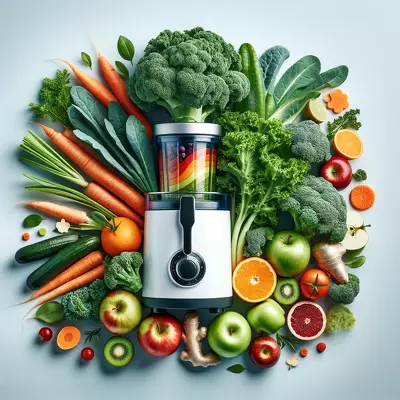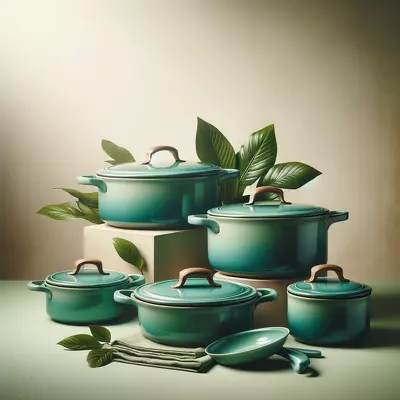Sustainable Cooking: The Inside Scoop on GreenLife vs GreenPan Cookware
In the quest for healthier cooking options, many consumers find themselves comparing different brands of eco-friendly cookware. Two leading names in this space, GreenLife and GreenPan, offer products that not only promise non-toxic, safe cooking surfaces but also emphasize sustainability in their production processes. This article explores the distinctions between these brands, focusing on their materials, performance, and environmental impact to help readers make an informed decision for their kitchens.
As an Amazon Associate, we earn a commission from qualifying purchases.
I. Introduction
A. Overview of Eco-Friendly Cookware
The rise of eco-friendly cookware marks a significant shift in consumer preferences towards products that align with a sustainable lifestyle. These cooking tools are designed to minimize environmental impact, using materials and manufacturing processes that are less harmful to the planet. They offer an alternative to traditional cookware, which often relies on chemical coatings and metals that can be detrimental both to the environment and human health.
B. Importance of Choosing Sustainable Kitchen Products
Opting for sustainable kitchen products is more than a trend; it’s a crucial step in reducing one’s carbon footprint and promoting a healthier lifestyle. The materials used in eco-friendly cookware, such as recycled aluminum or ceramic coatings, not only ensure a non-toxic cooking surface but also contribute to less waste and lower emissions during production. By choosing these products, consumers support sustainable practices that preserve natural resources and promote a healthier planet.
II. GreenLife Cookware
A. Product Range and Features
GreenLife offers a wide array of cookware that caters to various cooking needs, including frying pans, saucepans, and complete cookware sets. Their products are known for their vibrant colors and innovative designs. A key feature of GreenLife cookware is its Thermolon ceramic non-stick coating, which is derived from sand and free from PFAS, PFOA, lead, and cadmium, ensuring safe cooking at high temperatures without releasing toxic fumes.
B. Material and Sustainability
The brand emphasizes sustainability by using recycled aluminum for the base of its cookware, reducing energy consumption and waste. The non-stick ceramic coating not only provides an easy cooking experience but also ensures easy cleanup, further reducing the amount of water and detergent needed.
C. User Experience and Performance
Customers often praise GreenLife for its exceptional non-stick performance, lightweight design, and ease of use. The cookware heats up quickly and evenly, allowing for efficient cooking with less energy. The ergonomic handles provide a comfortable grip, enhancing the overall cooking experience.
III. GreenPan Cookware
A. Product Range and Features
GreenPan is another frontrunner in the eco-friendly cookware market, offering a variety of pots, pans, and complete sets designed for health-conscious cooks. Their patented Thermolon ceramic non-stick coating is applied without the use of PFAS and PFOA, providing a safe and durable cooking surface. GreenPan sets itself apart with its focus on professional-grade cookware that caters to both home cooks and culinary professionals.
B. Material and Sustainability
GreenPan’s commitment to sustainability is evident in its choice of materials and manufacturing processes. The use of recycled aluminum and the solvent-free application of its non-stick coating significantly reduces the environmental impact. Additionally, the cookware is designed for long-term durability, lessening the need for frequent replacements and further contributing to waste reduction.
C. User Experience and Performance
GreenPan cookware is celebrated for its superior heat distribution and robust non-stick performance. The Thermolon coating allows for cooking with minimal oil, promoting healthier eating habits. Users also note the cookware’s resilience to scratching and peeling, even when used with metal utensils, underscoring its durability.
IV. Comparative Analysis
A. Material Differences
While both GreenLife and GreenPan utilize Thermolon ceramic for their non-stick surfaces, the application process and the composition of the base material vary slightly, affecting their thermal conductivity and durability. GreenPan often targets a more upscale market with additional features designed for intensive use.
B. Cooking Performance
Both brands perform admirably on the stove, offering even heat distribution and effective non-stick surfaces. However, GreenPan’s focus on professional-grade products may give it a slight edge in terms of heat resilience and cooking precision.
C. Durability and Longevity
Durability is a strong suit for both brands, though GreenPan’s cookware tends to have a slight advantage in withstanding high heat and abrasive cleaning over time. This resilience contributes to its longevity, making it a potentially more cost-effective choice in the long run.
D. Price Comparison
GreenLife cookware is generally more affordable, making it an attractive option for those on a budget. GreenPan, with its emphasis on professional-grade quality, commands a higher price point, which is justified by its enhanced features and durability.
E. Environmental Impact
Both brands are committed to reducing environmental impact, though their approaches vary. GreenLife focuses on the consumer market with an emphasis on colorful, user-friendly designs, while GreenPan caters to a more demanding clientele with professional-grade cookware. Both, however, use sustainable materials and manufacturing processes.
V. FAQs
Q: Are GreenLife and GreenPan cookware dishwasher safe?
A: Yes, both brands offer dishwasher-safe options, but hand washing is recommended to extend the life of the cookware.
Q: Can I use metal utensils with GreenLife and GreenPan cookware?
A: While both coatings are more resilient than traditional non-stick surfaces, using wooden or silicone utensils is advisable to avoid scratching the surface.
Q: What is the main difference between GreenLife and GreenPan cookware?
A: The main difference lies in their target markets and product offerings. GreenLife focuses on affordability and vibrant designs for everyday use, while GreenPan offers professional-grade cookware with enhanced durability and performance features.
Q: Are these brands’ products free from harmful chemicals?
A: Yes, both GreenLife and GreenPan cookware are free from PFAS, PFOA, lead, and cadmium, making them safe for cooking at high temperatures without releasing toxic fumes.
Q: How does the Thermolon ceramic coating compare to traditional non-stick coatings?
A: Thermolon ceramic coatings are more environmentally friendly, safer for health as they do not release harmful chemicals when heated, and are more durable than traditional non-stick coatings.
Q: Can GreenLife and GreenPan cookware be used on induction cooktops?
A: Yes, many models from both brands are compatible with induction cooktops, but it’s important to check the specific product details for compatibility.
Q: How can I extend the lifespan of my eco-friendly cookware?
A: To extend the lifespan, avoid overheating, use wooden or silicone utensils, wash hands with mild detergent, and follow the manufacturer’s care instructions.
VI. Conclusion
A. Summary of Findings
Our analysis reveals that both GreenLife and GreenPan offer high-quality, eco-friendly cookware options, with each brand catering to different segments of the market. GreenLife appeals to budget-conscious consumers looking for durable and non-toxic cookware with a playful design aesthetic. In contrast, GreenPan targets those willing to invest in professional-grade cookware that offers superior durability and cooking performance.
B. Final Recommendations
Choosing between GreenLife and GreenPan cookware ultimately depends on personal preferences, cooking needs, and budget. For everyday home use with an eye on budget and design, GreenLife is an excellent choice. For culinary enthusiasts or professionals seeking high-performance cookware that can withstand the rigors of intensive cooking, GreenPan is the better investment.
VII. Suggested Readings
In the world of eco-friendly cooking, knowledge is as crucial as the tools we use. To further explore this topic, consider the following recommended readings:
- “Cooking Green: Reducing Your Carbon Footprint in the Kitchen” by Kate Heyhoe – This book offers practical tips on how to make your kitchen more eco-friendly, including choosing sustainable cookware.
- “The Conscious Kitchen” by Alexandra Zissu-Zissu explores how every aspect of our food, including the cookware we use, affects our health and the environment, guiding making better choices.
- “Eco-Friendly Chef: Minimizing Waste and Maximizing Taste” by Jennifer Hill Booker – Booker combines her passion for delicious food with a commitment to sustainability, offering recipes and tips for eco-conscious cooking.
- “Green Kitchen Travels: Healthy Vegetarian Food Inspired by Our Adventures” by David Frenkiel and Luise Vindahl – This book captures the essence of sustainable eating through international cuisine, emphasizing fresh, local ingredients and eco-friendly practices.
- “Sustainable Home: Practical Projects, Tips, and Advice for Maintaining a More Eco-Friendly Household” by Christine Liu – Liu’s guide extends beyond the kitchen, offering insights into creating a greener, healthier home environment, including the selection of cookware.
These readings not only enrich our understanding of eco-friendly cooking practices but also inspire us to make informed choices that benefit our health and the planet. As we continue to navigate the vast world of sustainable living, let these resources guide our journey towards a more conscientious and environmentally friendly lifestyle.






